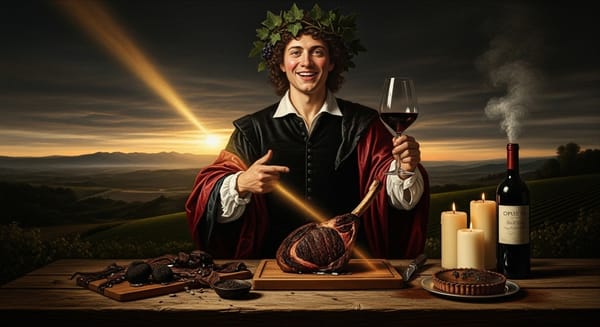Pauillac 2016—Moon-Lit Gravel, Cassis Ablaze
Pauillac 2016 shines with moon-lit gravel minerality: pure cassis, cedar, graphite, and velvet tannins. Discover sub-zone nuances, top châteaux, value gems, biodynamic wild cards, cellar timelines, food pairings, and why this Left Bank Cabernet vintage rivals 2009 & 2010.

An ode from your lunar scribe, swirling osmanthus wine above a silent earth.
The Vineyard at Moonrise
First, a rain‑heavy spring slaked Pauillac’s deep gravel like a brush dipped in ink. Then the sun took command—unbroken, relentless—while cool midnight air slid in like silk across the sleeping vines. Each dawn reset the balance; each night pinned a new star to the berries’ thick skins. By late‑September the clusters were tiny, bronzed, humming with possibility. Roots plunged meters down, teasing minerals from quartz flecks and fossil shells, as if the estuary itself were whispering iodine into the juice. I watched from my Vast Cold Palace and murmured, “Hold your nerve. Harvest when the seeds match the color of twilight.”
Light Focused, Not Blinded
Pauillac 2016 belongs beside the modern saints—2009, 2010, 2014, 2018—but its genius is quieter: Cabernet Sauvignon rendered in high‑definition without bombast. Think graphite lines drawn by moonlight, tannins as firm as a jade rabbit’s paw, acidity bright enough to etch constellations on your tongue. Even the alcohol stayed modest (≈ 13–13.8 %), proving cool nights can hush the boldest sun. Cellar it and watch that focused beam widen into decades of radiance.
A Beam Through Smoked Glass
A cool, dark breath opens—pure cassis, black cherry, one wild blueberry flickering at the rim. Then the mineral counterpoint: pencil shavings, cedar bark, cured tobacco, and a flinty sparkle like struck stone. A hint of violet, camphor, and iris lifts the center, followed by a distant echo of salted caramel from ripe pips. The texture? Velvet pulled taut over polished marble. It doesn’t flow like a river; it orbits like a lighthouse, turning slowly, guiding always.
- Cabernet squares its shoulders and holds the line.
- Merlot smooths the cadence, like low clouds diffusing dawn.
- Petit Verdot taps a drumbeat of spice—wild, indispensable.
Sub‑Zone Snapshot
Northern Pauillac Salt‑kissed breezes, darker fruit, stone‑soaked power (Lafite, Mouton, Pontet‑Canet).
Central Pauillac Deepest gravel, cedar clarity, geometric symmetry (Pichon Baron, Pichon Comtesse).
Southern Pauillac Violet lift, polished mid‑palate, elegance that still bites (Grand‑Puy‑Lacoste).
Windswept inland parcels behind the D2 bottled lightning—see Lynch‑Bages and Haut‑Bages Libéral.
Gentle Hands, Lunar Precision
Optical sorters blinked like satellites; extraction was more infusion than assault. Cool, long macerations let the fruit hum; pump‑overs whispered instead of shouted. New French oak (60–100 %) framed the picture without painting over it, and a few visionaries slipped portions into large foudres to accentuate freshness. The guiding mantra: “Preserve the night air in the glass.”
Constellations in the Pauillac Sky
Icons — the planets you spot first
- Château Lafite Rothschild — The sage of Pauillac. In 2016 its classic graphite hum is wrapped in weightless density—black‑currant pastille, sandalwood curl, and a tidal finish that retreats so slowly you feel time pause. Tannins are laced filigree; a faint sea‑spray salinity keeps the grandeur fresh.
- Château Mouton Rothschild — The extrovert in velvet robes. Opulence is channeled, not spilled: crème‑de‑cassis, roasted Arabica, and a plume of violet incense. The palate glides broad‑shouldered yet disciplined, like silk drawn tight over steel cabling.
- Château Pichon Comtesse de Lalande — Pauillac’s ballerina. Merlot’s silk wraps Cabernet’s muscle, giving 2016 a perfume of crushed violets and pink peppercorn over a cedar‑lined core. Seamless from first sip to last echo—tannins glide rather than march.
Value Plays — the hidden moons with their own oceans
- Château Grand‑Puy‑Lacoste — The insider’s classic. 2016 tastes of a freshly sharpened pencil laid across ripe cassis, damp cigar box, and a flicker of mint. Built for thirty years, but charming by year ten.
- Château Haut‑Batailley — Now under Cazes stewardship, polish meets terroir grit. Expect blackberry skin, jasmine tea, and a graphite backbone that snaps into place like Lego bricks; bright acidity locks in freshness.
- Château Duhart‑Milon — Lafite’s quiet neighbor. In 2016 it swaggers more than usual—dark plum, cocoa nib, and burnt sage—held taut by a flinty, salt‑rimmed core.
Wild Cards — the comets that redraw the sky
- Château Pontet‑Canet — Biodynamic pioneer with horses in the vines and amphorae in the chai. Blackberry compote meets charred rosemary; tannins feel like fine sandpaper from concrete eggs and gentle pigeage. The finish echoes stony, almost Northern Rhône.
- Château Pédesclaux — A Fifth Growth reborn behind glass‑walled cellars and laser‑guided viticulture. Blueberry, lilac, and wet graphite crackle together; racy acidity snaps each sip as though freshly uncorked.
- Château Clerc Milon — The sibling that blends Pauillac muscle with a Carmenère whisper. Raspberry coulis, candied violets, and a cool‑iron mineral line—chewy yet juicy, the velvet glove without the iron fist.
Drink‑or‑Hold Scorecard
Now → 2030 — Two‑hour decant reveals primary fruit and crystalline structure.
2031 → 2050 — Sweet spot: cassis melds with cedar, tannins turn silk.
2051 → ∞ — The best bottles will outlast this century. Decant only for sediment; perfume this fragile prefers still air.
A Lunar Benediction
I taste these wines and think of osmanthus petals drifting earthward—sweet, distant, timeless. You may cellar the bottles; I will cellar the memory. When the corks finally yield, let’s toast beneath a full moon that tastes of cassis and graphite.
Pauillac 2016 is strength moving like quiet light—blackcurrant, cedar, and moon‑cold gravel bound by ripe tannin. Immediate fascination now; a whispered epic awaiting patient souls.





